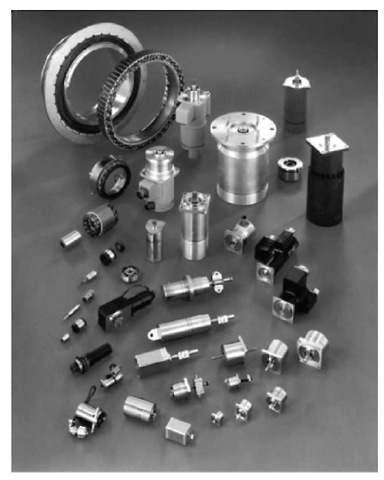In conventional DC motors with brushes,
the field winding is on the stator and armature winding is on the rotor. Because of the brushes, the motor is expensive and needs maintenance. In addition, accumulation of the brush debris, dust, and commutator surface wear as well as arcing cannot be permitted in certain hazardous locations, which limits the application of DC brushed motors. As solid-state switching devices have been developed, it became possible to replace the mechanical switching components (commutator and brushes) by electronic switches. In fact, a brushless DC (BLDC) motor has a permanent magnet rotor and a wound field stator, which is connected to a power electronic switching circuit. Rotor position information is required for the power electronic driver. Figure 8.1 shows brushless DC motor drives and Fig. 8.2 a typical BLDC motor.
According to the National Electrical Manufacturers Association (NEMA), “a brushless DC motor is a rotating self-synchronous

FIGURE 8.1 Brushless DC motor drives. (Courtesy MPC Products Corporation, Skokie, IL.)
machine with a permanent magnet rotor and with known rotor shaft positions for electronic commutation.” The advantage of brushless configuration in which the rotor (field) is inside the stator (armature) is simplicity of exiting the phase windings. Due to the absence of brushes, motor length is reduced as well. The disadvantages of the brushless configuration relative to the commutator motor are increased complexity in the electronic controller and need for shaft position sensing.
Main advantages of the BLDC motor drives are high efficiency, low maintenance and long life, low noise, control simplicity, low

FIGURE 8.2 Typical BLDC motor, developed by Infranor Inc., Naugatuck, CT.
weight, and compact construction. On the other hand, the main disadvantages of the BLDC motor drives are high cost of the permanent magnet materials, the problem of demagnetization, and limited extended speed, constant power range (compared to a switched reluctance machine).
Brushless DC motors can be classified based on the shape of their back EMF: trapezoidal or sinusoidal. In a BLDC motor with trapezoidal back EMF, the permanent magnets produce an air gap flux density distribution that is of trapezoidal shape. These motors, compared to motors with sinusoidal shape back EMF, have higher torque and larger torque ripples. They are also cheaper and used for general applications. In a BLDC motor with sinusoidal back EMF, the permanent magnets produce an air gap flux density distribution that is sinusoidal. These motors, compared to motors with trapezoidal shape back EMF, have smaller torque ripples. They are also expensive and are used for servo applications.
